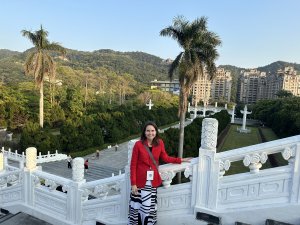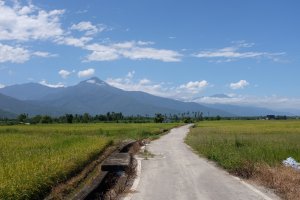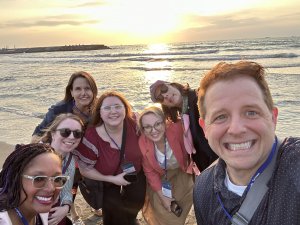I was very honored to receive the opportunity to conduct my research project in UC Berkeley, US in the academic year of 2015-2016. My project was supported by both the Fulbright-Formosa Plastics Group Senior Scholar Scholarship and The Top University Strategic Alliance in the Republic of China (Taiwan). What follows is a brief summary of the research and my personal reflections.
Research
Populations of older adults are increasing dramatically worldwide, especially in Taiwan. Aging populations have major social and economic consequences. Such consequences can be mediated by active aging. Reducing sedentary lifestyles and increasing social participation represent identifiable preventative strategies. However, developing initiatives to increase physical activity among seniors remains a pressing challenge in public health.
Park and recreation professionals are as important contributors since built- environments, especially recreational sites and parks, are the preferred venues for most seniors for increasing physical activity, and these places are more effective than other programs in terms of sustainability and reaching populations. Framed from a socio-ecological model, this research project investigates various factors, including informational, socio-cultural, natural, intrapersonal, perceptional, behavioral, circumstantial, and governmental environments to examine the effect of park-based physical activity on seniors’ health in conjunction with a comparison between Taiwan and the United States (US).
I have conducted literature reviews, in-depth interviews, and field observations on several parks in California. I also identified many professional societies in the US, such as the National Recreation and Park Association, Active Living Research from the Robert Wood Johnson Foundation, and The Trust for Public Land, which all strive to create and sustain healthy, livable communities for generations to come.
During my stay in California, I visited several parks, in both northern and southern California, to observe park users and their behaviors. Moreover, interviews with people involved in promoting active aging in parks, such as urban planners, bureaucrats, park managers, senior park users, and other policy or strategic stakeholders, provide potential sources to clarify missions, visions, obstacles, challenges, and effects to help successfully increase physical activities in parks by the targeted population from a socio-ecological model.
The aim of this project is to further investigate and compare the similarities and differences of promoting active aging in Taiwan and the US, based on the multi-levels of a healthy behavioral socio-ecological model. A brief summary of this comparison of the literature review, field observations, and interviews follows.
Many social problems exist today that need to be addressed. For instance, environmental deterioration is an ever-present concern as increasing urbanization has led to the disappearance of green space. Obesity has become an increasing public concern and has the potential to lead to many chronic diseases. Social inequity within communities is also a potential threat to people’s psychological health and is a source of many conflicts. Each of these issues is complex and should not be ignored. Ignoring them could result in serious consequences. The park and recreation services are trying to play a role in combating (and eventually solving) these issues with the three pillars: conservation, health and wellness, and social equity. My firm belief is that active parks play important roles in creating healthy, resilient, and sustainable communities. A park gives an excellent snapshot of an urban environment. It reflects genuine interactions and desires of a city’s residents.
The goal is to effectively promote park-based physical activity and reduce the social cost of health problems due to insufficient physical activity. Dissemination of the results has occurred in invited lectures and conferences to influence active-aging advocates, policies, and social change.
Reflections
The most significant experience for my research project and personal life is the value of cultural diversity.
The population in California is comprised of people with very diverse backgrounds. As such, I had the opportunity to interact with people from various cultural backgrounds in my daily life. It is very interesting to learn and know people with diverse backgrounds, cultures, and experiences. The exchange of ideas and perceptions allows me to better understand the meanings and beliefs of each individual culture. For example, many European-American people value individualism, while the Asian and Latino population view collectivism as important. This dichotomy could be reflected clearly from the behaviors of park visitors. From my observations, I have noticed that Mexican-Americans are more likely to use parks for family activities, like picnics or family reunions, while Caucasians are more likely to partake in individual recreation activities, such as jogging, walking their dogs, or ball games. In California, the majority of park users are families with young kids. This scenario is in stark contrast to Taiwan, where the majority of park visitors are senior citizens.
In the US, many local municipal governments have specific Parks and Recreation departments to manage and maintain municipal parks and recreation facilities and to provide and administer recreation programs. These parks host many events and partner with other agencies to put on festivals throughout the year to attract families. For example, in Berkeley, in celebration of fall harvest, San Pablo Park hosts a fall harvest festival with games, booths, and music. In Goleta, Girsh Park hosts the annual California Lemon Festival with games for kids, arts and crafts vendors, and live bands.
Other than the big events and festivals, I have seen that many physical activities have been added to park schedules to promote an active living lifestyles. For instance, the San Francisco Parks and Recreation department hosts weekly Zumba® classes in many local parks to draw residents to the park for an enjoyable workout. One initiative led by university students offers free exercise sessions in the parks. In order to reach different cultural backgrounds, the flyers are printed in English, Spanish, and Chinese. These new initiatives of group exercise programs were uncommon in U.S. parks until recently. On the contrary, these events have been very popular for a long time in East Asian countries like China, Taiwan, and Japan. In these places, many adults, especially seniors, attend group exercise programs, such as Tai-chi, folk dance, or various forms of martial arts, for free or at a very minimal cost.
It is quite important to observe the differences, similarities, and changes between different cultures. I have been researching how the built-environment has shaped our active lifestyles. When I first visited the US in 1997, I realized that I had to drive to almost every destination that I wanted to visit; this is much different than Taipei, where I grew up and could walk or take a short-distance bus to shops, schools, parks, banks, or hospitals. While I do enjoy the less crowded and dense public spaces, I realized that the US has called attention to the epidemiology of obesity, resulting from the lack of physical activity opportunities in daily lives. Now, several research groups and campaigns in the US have devoted time to oppose the suburban sprawl by encouraging mixed zone usage, building safer bike or walking routes, and providing convenient public transportation transits in lieu of expanding highways. This movement has gradually changed people’s preference as I noticed recently that the index of walkability or distance to public transits have started to be listed on apartment renting or housing selling information, in addition to the size or sale price that traditionally are posted for real estate.
My research project in California has lead me to appreciate the beauty of diversity. I realize that people benefit from interactions with different cultures or diverse backgrounds. Each culture has its own wisdom that is worth learning. By learning from each other, we can set ourselves on a path to a more balanced and bright future. In addition, by learning from each other, we achieve the goal of the Fulbright program of “A little more of understanding and a little less of conflict.”
In addition, I am very thankful for the Fulbright program for hosting many intellectual and social programs. These programs not only allowed me to meet and interact with other scholars or students, but they also helped me to further understand US culture and broaden my horizon of knowledge. For example, I attended the Fulbright Northern California annual conference at Asilomar Conference Grounds, Pacific Grove. The theme for this conference was “The Oceans: Managing Critical Issues.” I learned from various professionals that the ocean’s sustainability is not solely dependent upon one discipline or one particular region. Instead, since the ocean is connected globally, it requires every discipline and person from all over the globe to devote themselves to the task. I also realize that human survival depends on the health of the ocean, not only for healthy seafood to consume but also the whole eco-system we rely upon.
The merit of international collaboration is to increase mutual understanding between people from different countries and cultures. This project directly addresses this goal through understanding US strategies, sharing expertise gained in Taiwan, and integrating different systems and cultures for shaping policies, implementations, environmental differences, and seniors’ motivations and perceptions. Due to the growing number of Chinese immigrants in the US, the result of this scholarship can benefit both countries when formulating initiatives for active aging among diverse cultures.
Finally, thank you again for this great funding and support from the TUSA, Fulbright, UC Berkeley, and National Cheng Kung University I will continue to study the role of parks in shaping seniors’ health. In addition, I have empowered myself and am better equipped to give back to students and the communities to have a positive influence on others by encouraging them to embrace the value of diversity and to advocate parks for active aging.






